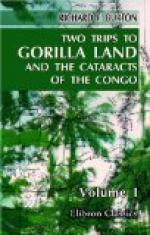From this point we could easily see the wide gape of the Rembwe, the south-eastern influent, or rather fork, of the Gaboon, which rises in the south-western versant of some meridional chain, and which I was assured can be ascended in three tides. The people told me when too late of a great cavity or sink, which they called Wonga-Wonga; Bowdich represents it to be an “uninhabited savannah of three days’ extent, between Empoongwa and Adjoomba (Mayumba). I saw nothing of the glittering diamond mountains, lying eastward of Wonga-Wonga, concerning which the old traveller was compelled to admit that, “when there was no moon, a pale but distinct light was invariably reflected from a mountain in that quarter, and from no other.” It has now died out—this superstition, which corresponds with the carbuncle of Hoy and others of our Scoto-Scandinavian islands.
Resuming our cruize on the next day, we passed on the right a village of “bad Bakele,” which had been blown down by the French during the last year; in this little business the “king” and two lieges had been killed. The tribe is large and important, scattered over several degrees north and south of the equator, as is proved by their slaves being collected from distances of several weeks and even months. In 1854 Mr. Wilson numbered them at 100,000. According to local experts they began to press down stream about 1830, driven a tergo by their neighbours, the Mpangwe (Fan), even as they themselves are driving the Mpongwes. But they are evidently the Kaylee or Kalay of Bowdich (p. 427), whose capital, “Samashialee,” was “the residence of the king, Ohmbay.” He places them in their present habitat, and makes them the worst of cannibals. Whilst the “Sheekans” (Shekyani) buried their dead under the bed within the house, these detestable Kaylees ate not only their prisoners, but their defunct friends, whose bodies were “bid for directly the breath was out of them;” indeed, fathers were frequently seen to devour their own children. Bowdich evidently speaks from hearsay; but the Brazil has preserved the old traditions of cannibalism amongst the Gaboes.
The Bakele appeared to me very like the coast tribes, only somewhat lighter-coloured and wilder in look, whilst they again are darker-skinned than their eastern neighbours from the inner highlands. Their women are not so well dressed as the “ladies” of the Mpongwe, the chignon is smaller, and there are fewer brass rings. The men, who still cling to the old habit of hunting, cultivate the soil, practise the ruder mechanical arts, and trade with the usual readiness and greed; they asked us a leaf of tobacco for an egg, and four leaves for a bunch of bananas. Missionaries, who, like Messrs. Preston and Best, resided amongst them for years, have observed that, though a mild and timid people, they are ever involved in quarrels with their neighbours. I can hardly understand how they “bear some resemblance to the dwarfish Dokos of the eastern coast,” seeing that the latter do not exist.




